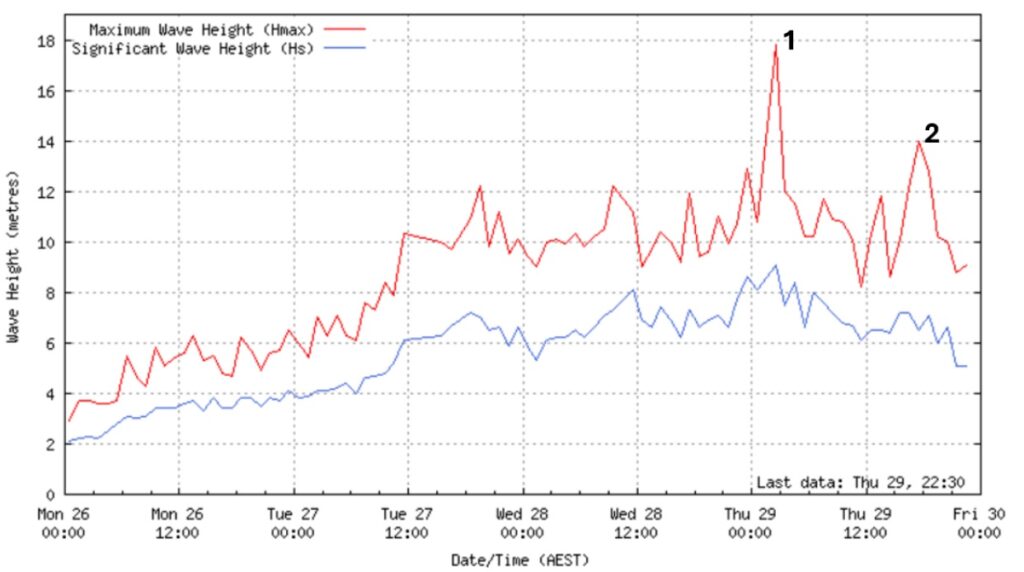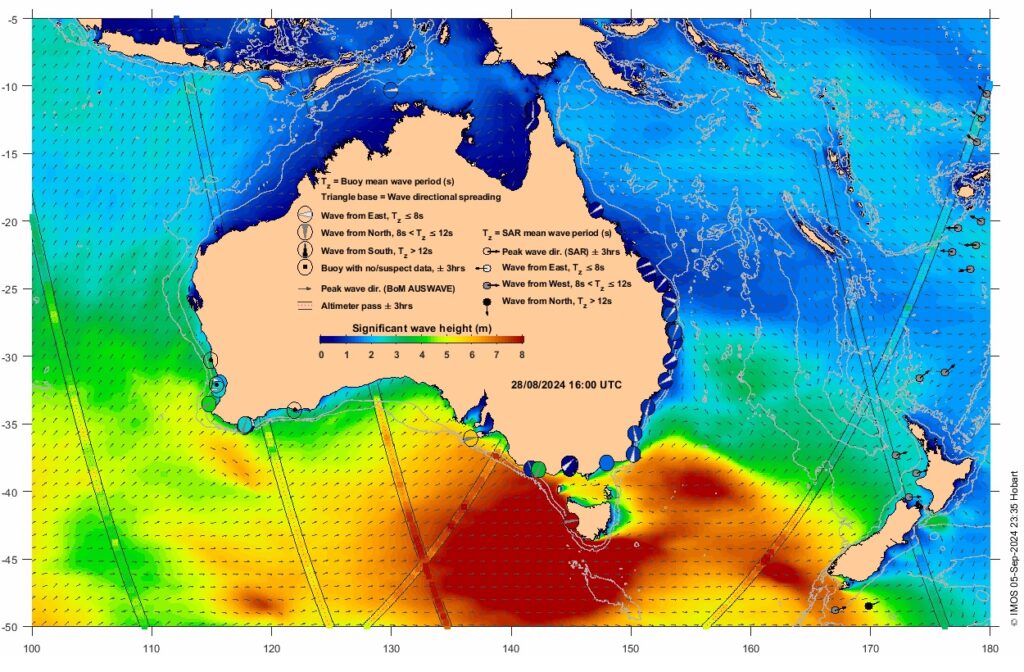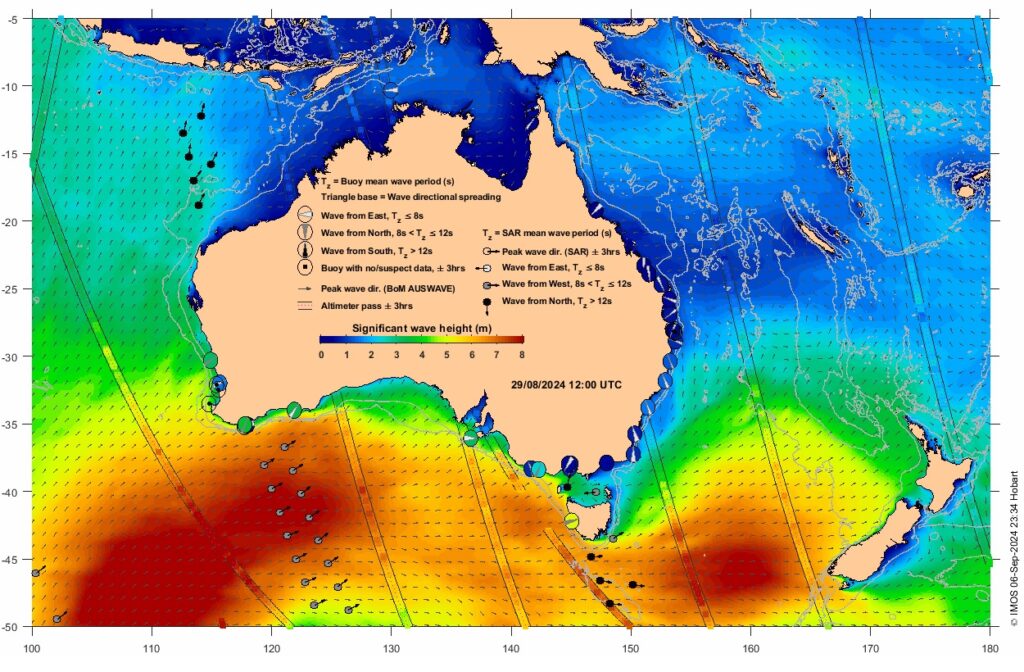SLWCE Feature Article
Rogue Waves off the Tasmanian Coast: A Rare Event or Unnoticed Giants of the Southern Ocean?
Cagil Kirezci
23 September 2024
On the 29th of August 2024, around 02:00 local time, the Cape Sorell wave buoy recorded a massive individual wave nearly 18 meters high — roughly the height of a six-storey building or an air traffic control tower. This occurred in a sea state where the significant wave height (Hs) was just over 9 meters. Nearly a day later, the same buoy registered another towering wave of 14 meters in a sea state with an Hs of 6.5 meters. The commonly accepted criterion for a rogue wave—once regarded as mere sailors’ tales—is for an individual wave to reach or exceed twice the height of the surrounding sea state’s significant wave height (Hi/Hs > 2). Although the first wave fell just short of this threshold, it came remarkably close. The second wave significantly surpassed the criterion.

Figure 1. Time series of wave buoy data at Cape Sorell (source: Bureau of Meteorology).
Between the news of havoc-wreaking winds, flooded coastal areas across southern states, and stunning surf photographs of breaking waves and rainbows in the ocean spray on Victoria’s surf coast, these extraordinary wave gauge recordings off the coast of Tasmania went largely unnoticed. While Bodhi and his friends were chasing the swell of the mythical “50-year storm” at Bells Beach (a cheesy “Point Break” reference), six-story giant waves were forming amid the Southern Ocean storm off Tasmanian coast.
Rogue waves, once considered a myth based on anecdotal evidence, are now more frequently observed, thanks to the increasing number of recordings and the emergence of new observation techniques. Most reports of these extreme waves describe them as either sudden “walls of water” — indicating their unusual steepness — or as “holes in the sea,” which refer to deeper-than-normal troughs. These events have been known to cause significant damage to ships and lead to human casualties.
Rogue waves are statistically rare events, both according to in-situ ocean observations and short-term statistical models that rely on distributions based on second-order wave theory (where only the effects of bound waves are considered). In other words, encountering such a phenomenon is highly unlikely.
So, were these two recordings at Cape Sorell rare events, coincidentally captured by the buoy? Or are such rogue waves happening far more frequently than we realise?
This is a complex question. First, we need to understand how rogue waves form. Several physical mechanisms are known to cause the formation of rogue waves, and we will name the most suspected mechanisms here. One mechanism is the superposition of waves due to the waves’ dispersive nature. Such mechanism can lead to the formation of rogue waves in two main ways: through the interaction of waves traveling at different speeds (i.e., dispersive or spatio-temporal focusing) or through the intersection of wave systems coming from different directions (i.e., directional or geometric focusing). Rogue waves can also emerge due to higher-order nonlinear processes, particularly the modulational instability (aka Benjamin-Feir instability), where steep, narrow-banded wave trains become unstable to sideband modulations. In the real ocean, dynamic effects such as nonlinear energy exchange and resonances can trigger instabilities that lead to rare, transient events of exceptionally high waves. These occurrences cannot be explained by simple geometric approaches due to their transient and unpredictable nature. Wave steepness and spectral bandwidth are key factors influencing nonlinearity and dispersion in sea states. Modulational instability is known to occur in random wave spectra when the wave steepness is sufficiently large and the spectral bandwidth is sufficiently narrow (Onorato et al., 2006). Due to the rarity of such events, they are unlikely to be captured in regular observations.
Other factors associated with rogue wave formation include wave-current interactions, where waves encountering strong opposing currents can shorten in wavelength and increase in height; and bathymetric effects, such as shoaling, which can cause wave focusing. While strong winds typically limit the individual wave growth by blowing the crests off, they can, under certain conditions, contribute to nonlinear instability and the formation of rogue waves. There is still active debate in the scientific community regarding the various factors that cause rogue waves, and which mechanisms are the most active/influential.
In the case of the Cape Sorell events, determining the exact generation mechanism behind these potential rogue waves is challenging due to the complex nature of wave dynamics. Additionally, real-time surface recordings are not immediately transmitted onshore, and were not available at the time, further complicating efforts to provide a more precise analysis. Therefore, in this article, the discussion will rely on educated guesses based on storm conditions and the location of the events and unequivocally, will not go beyond speculations.
The model information from the AUSWAVE wave model (Bureau of Meteorology forecast model) suggests that late August storm event exhibits the commonly observed characteristics of a Southern Ocean storm scenario, characterised by unimodal wave spectra driven by strong westerlies. However, this storm was obviously much more powerful than an average storm and was traveling at slightly lower latitudes, directly impacting Tasmania.
At the time of the first rogue wave record of ~18 meters wave height, the storm was at its peak, impacting the west coast of Tasmania. At that moment, the wave steepness of 0.085 (can be considered high) suggests that nonlinear interactions were prominent. Given the location of the wave buoy, the storm’s characteristics, and the strong winds, modulational instability emerges as a likely candidate for this rogue wave formation.

Figure 2. Wave conditions on August 29th, 2024 at 02:00AM TAS local time with the Cape Sorell wave buoy (west of Tasmania) showing significant wave height exceeding the colour scale. (source: IMOS OceanCurrent Surface Waves).
For the second rogue wave event, where a 14-meter wave was recorded, the storm had already passed its peak. The wave system at this point was “older” (relative to the wind speed that generated the waves), indicating reduced nonlinearity and lower steepness. With no active crossing sea states or significant superposition due to diffraction, the possibility of rogue wave formation due to dispersive focusing increases. Unfortunately, these analyses are inconclusive but may offer useful insights in understanding the formation of these rare and equally fascinating events.
Finally, on the frequency of these events, theoretical statistical distribution functions suggest that the likelihood of such rogue waves occurring is less than 1 in 10,000-20,000 waves. Given a typical 20-minute wave record, which contains approximately 100-300 waves, the occurrence of a rogue wave event within such a record is expected to be rare. However, data collected by the Southern Ocean Flux Station (SOFS1-4) indicates that in storms with similar or higher steepness conditions, rogue waves were recorded in frequency of approximately 1 in 20 events. Additionally, a review of recent measurements retrieved from AODN portal for 31 buoys around Australia shows that, over the past 15 days, 958 out of 12,050 records contained waves meeting the rogue wave condition of Hi/Hs>2. Nevertheless, many of these events, are not truly rogue waves but are instead smaller waves that only satisfy the somewhat flawed “rogue” criteria. We see quite a few of them in Great Barrier Reef region, probably formed by directional focusing caused by waves diffraction off the reefs and due to bathymetric conditions. However, numerous large waves (Hi>10m) are observed by the Western Australia buoys, in addition to the Cape Sorrell wave buoy, which could have posed significant risks to marine operations. An important point to also consider is that these observations were taken from single point measurements which underrepresents the extreme sea state occurrences due to being bounded to a “tunnel vision”. An extreme individual wave could be formed near the buoy location and not detected in the records. Several studies show that wave crest maxima acquired from space-time records are generally larger than the values expected at a single point of observation.

Figure 3. Wave conditions on August 29th, 2024 at 10:00PM TAS local time. (source: IMOS OceanCurrent Surface Waves).
The key takeaway from our analysis of these two giant waves is that rogue waves may be far more common than we realise. And that, yes, the events captured by the Cape Sorell wave buoy are indeed rogue waves.
Despite advancements in observation techniques and research on rogue waves, there is still much more to learn about this extraordinary wave phenomenon. Until then, the ocean’s unpredictable nature remains a powerful force, always ready to surprise us.
References
Babanin, A. V., & Rogers, W. E. (2014). Generation and limiters of rogue waves. The International Journal of Ocean and Climate Systems, 5(2), 39-49.
Benjamin, T. B., & Feir, J. E. (1967). The disintegration of wave trains on deep water Part 1. Theory. Journal of Fluid Mechanics, 27(3), 417-430.
Onorato, M., Osborne, A. R., Serio, M., Cavaleri, L., Brandini, C., & Stansberg, C. T. (2006). Extreme waves, modulational instability and second order theory: wave flume experiments on irregular waves. European Journal of Mechanics-B/Fluids, 25(5), 586-601.
Other related news: Rogue waves battering Southern Australia (IMOS OceanCurrent Surface Waves)
